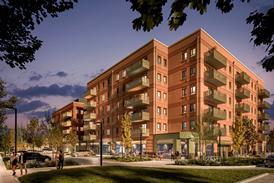Gillian Darley’s antipathy towards archaeology is challenged by a visit to the London Mithraeum

A confession. Archaeological sites have never done much for me. Those sparse outlines of long gone buildings of unclear purpose nudging through the grass, those unconvincing shoulder high flint lumps, smoothed off in the interests of safety and long ago shorn of their shabby cloaks of ivy, fail to move me. Give me a gable end, punctured by a half rose window, or a line of columns where an arcade once stood, and I can begin to imagine some version of past religious practices. J.M.W. Turner’s painting of the ruined Refectory at Kirkstall Abbey hits the right note for me, shafts of light pouring in, long and low to illuminate a few architectural features, a capital, a corbel, a column. Centre stage a huddle of cattle gather around one of the columns to lighten the mood.
A New Year’s resolution to challenge pointless prejudices is no bad thing. A visit over the holidays to the London Mithraeum, a primitive temple dating from the mid 3rd century AD and now reinstalled seven metres below pavement level, under Foster & Partners new Bloomberg headquarters in the City, my objections to archaeological conjecture were here at least defeated.
When bomb damage revealed the Temple of Mithras in 1952 a lengthy excavation ensued to enormous public interest. In 1954 the temple was dismantled and rather carelessly reconstructed 100 metres away where it remained until 2010. Since then, the collective expertise of the City’s historic environment team and Museum of London archaeologists (MOLA), allied to a multi-faceted design team has worked a miracle. The extraordinarily effective ‘experience’ (their word, not mine) created constitutes a kind of atmosphere by design, giving an essential mystery back to the cult around Mithras and his symbolic killing of the bull, a fertility rite that may have hinted at the cult’s take on creation myth. Some fabric from the actual temple has been found but is too fragile for display.
Despite our lack of knowledge about the cult and the relative lack of authenticity of materials due largely to the heavy- handed treatment towards the reconstructed ruin in the 1950s, it packs a huge punch. Misty and phased lighting, subtle use of sound, painstaking choice of materials to complement what remained as well as a firm exclusion zone between visitors and the site, and a control on numbers, all play their part in setting the atmosphere. In the Mezzanine Gallery you wait for admission but by the time you descend are much better informed.
The recent history of the site should also give us pause, a reminder that cities are the result of the complex, often accidental, layering of the past, physically as well as otherwise. The shoes, metalwork, wooden writing tablets and more that the Romans dropped into the Walbrook, at the time a tributary to the Thames, are now displayed at entrance level in the Bloomberg Space. No effort has been spared to demonstrate what the Mithraeum and the Roman London around it may have been. Crucial is the admission of how much we still don’t know. That shift, from the dominance of incontrovertible fact to the existence of more nuanced, humbler, telling of history is something to ponder, particularly this year as we hurtle into the unknown.
















2 Readers' comments